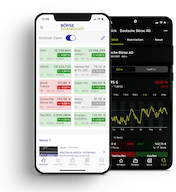Market sentiment: “Half full, half empty”

Investors are reacting to the latest developments in the customs debate by pulling back—from both sides, including profits.
Summary
Customs agreements and other news are driving German blue chips forward. Medium-term investors are retreating from various positions to the sidelines. Specifically: among professionals, 7 percent are bulls and 5 percent are bears, while among private investors, 14 percent are bears. Of this group, 4 percent have bought. Joachim Goldberg sees profit-taking on both the long and short sides as the motivation. Among professionals in particular, risk appetite has declined significantly.
The bottom line is that the relatively low number of optimists is remarkable. If DAX prices were to rise suddenly, many would find themselves in a bad situation and would be left behind. He expects demand at the lower end to start at 23,700 and 23,750 points. All in all, not a bad starting position.
30 July 2025. FRANKFURT (Goldberg & Goldberg). Last weekend showed once again that it is not only participants in the financial markets who make decisions based on reference points, i.e., whether they perceive something as a loss or a gain. This refers, of course, to the so-called tariff deal between the EU and the US, where quite a few commentators considered a tariff rate of 15 percent on EU exports to the US – compared to the 30 percent that had previously been on the table – to be a success, at least mentally. However, anyone who still had the period before the so-called Liberation Day with a very low reference point in mind must consider the 15 percent tariff – apart from many other concessions made by the EU – a failure.
And so stock market traders in this country also had difficulty initially assessing the so-called tariff deal. In the end, the DAX weakened temporarily, but at the time of writing today, after a trading range of around 2.4 percent since last Wednesday, it is down only 0.7 percent.
Strongly contrasting assessments
The institutional investors with a medium-term trading horizon that we surveyed also clearly had quite different assessments of the tariff deal. Both the bull and bear camps have shrunk significantly. The fact that there was such a strong shift toward neutral investors, with a difference of 12 percentage points, may be due in part to profit-taking in both camps. However, upcoming event risks certainly also played a role, such as today's meeting of the US Federal Reserve's Open Market Committee and the US labor market report, which is due to be released this Friday.
Of greater concern is the fear that, despite claims to the contrary, the tariff deal does not guarantee planning security for some. However, the decisive factor for the closing of positions in the past sentiment week was likely the cost prices of existing commitments, which prompted both bulls and bears to take profits. In the end, the polarization between the two camps has decreased significantly, with the Frankfurt Stock Exchange Sentiment Index losing 2 points on balance and now standing at -17.
At first glance, private investors have made a completely different decision. The Frankfurt Stock Exchange Sentiment Index in this panel rose by 18 points to a new level of +9. However, on closer inspection, it becomes clear that this shift in sentiment is largely attributable to those we surveyed via social media. While many opinions there shifted from bearish to bullish, sentiment among other investors also improved, but not nearly as strongly. For the most part, only bearish positions (presumably many with profits) were closed, and the main trend here is entirely toward neutral private investors. Although the Frankfurt Stock Exchange Sentiment Index has risen for this subgroup, at -21 it is still quite close to that of institutional investors.
Low risk appetite
Ultimately, today's survey revealed a clear divide in sentiment between private and institutional investors. It is striking that the proportion of neutral investors has increased significantly in both panels. Risk appetite has declined significantly, especially among institutional investors, although the balance between pessimists and optimists has actually widened slightly compared to the previous week – a sentiment index of -17 does not exactly indicate a balanced positioning.
In fact, optimists account for only 24 percent of all respondents, a comparatively low proportion this year. In other words, if there were to be a sudden rise in the stock market barometer, many investors would not be well prepared. However, in the event of a DAX decline, demand would probably be better than in the previous week, especially between 23,700 and 23,750 points. In the end, at least for the DAX, the glass is more half full than half empty.
by Joachim Goldberg
30 July 2025, © Goldberg & Goldberg für boerse-frankfurt.de
Your opinion matters: Market expectations of investors

Videokommentar
Sentiment index of institutional investors

| Bullish | Bearish | Neutral | |
| Total | 24% | 41% | 35% |
| vs. last survey | -7% | -5% | +12% |
DAX (change since last survey): 24,200 points (-70 points since last survey)
Frankfurt Stock Exchange Sentiment Index for institutional investors: -17 points (-2 points since last survey
Sentiment index of private investors

| Bullish | Bearish | Neutral | |
| Total | 42% | 33% | 25% |
| ggü. letzter Erhebung | +4% | -14% | +10% |
DAX (change since last survey): 24,200 points (-70 points since last survey)
Frankfurt Stock Exchange Sentiment Index for private investors: +9 points (+18 points since last survey)
About the Frankfurt Stock Exchange Sentiment Index
The Frankfurt Stock Exchange Sentiment Index ranges between -100 (total pessimism) and +100 (total optimism), with the transition from positive to negative values marking the neutral line.
More articles from this columnist
| Time | Title |
|---|





